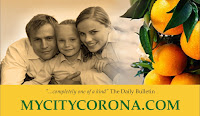
Borrowing a page from New York firefighters, the Corona Fire Department has set out to write a new chapter to its history that started in 1898.
Corona's Jim Steiner, Chris Yoshioka, Ryan Grooman and Mike Waters visited FDNY stations seven years ago. They saw the symbols New York firefighters use to build station unity and honor the history and unique characteristics of each group.
"Many of the rigs and stations had personalized names," said Steiner. "We thought we could bring the idea back to Corona to instill some station pride. All of the crews were challenged with coming up with their fire house name based on their history."
The challenge has been met. Corona's firefighters have parlayed humor, artistry, imagination, geography and history to create names and symbolic artwork for each of the department's seven stations.
Station 4 in Northwest Corona has adopted a pirate theme with the name, "Treasure Island" and a symbol that incorporates a skull and crossbones because the station is the base for the department's hazardous materials unit. The firefighters carry a bobble head pirate and a parrot doll on their fire truck.
Station 5, located on Canyon Crest in the Sierra del Oro area of west Corona, is called the "Prado Dragons" because the area overlooks the Prado Dam on the Santa Ana River. Steam rising from the river illuminated by the morning sun creates the illusion of fire, frequently causing motorists on Highway 91 to phone reports of fire that turn out to be false.
"They (Corona firefighters) would call it chasing the Prado dragon," said firefighter Mike Leckliter, who sketched a drawing of a dragon breathing fire that serves as the Station 5 symbol.
Corona Fire Chief David Waltemeyer said the icons have been very effective in solidifying station morale. "They breed a lot of unit pride and esprit de corps," the chief said.
The title of Station 1, "House of Blues," signifies what might be the toughest duty for firefighters in Corona. The firefighters at Station 1 have more calls in the middle of the night than any other station, said Capt. Fred Parr, who has worked at the post for 15 of his 26 years in the Corona fire service. He has no plans to move.
The station's district has more senior citizens than any other, which means its firefighters go to death calls in addition to traffic accidents and fires.
"This station is not for everybody," said Parr. "It takes a unique individual to work here. We get less sleep than any other fire house in the city."
Sleep is a treasured commodity at Station 2, whose Harrison Avenue location puts it close to the North Main Street Metrolink Station and the railroad tracks. The station proudly displays its logo, "Night Train" and "2nd to None" above and below and image of a train by the front door and in the television room of the station.
The station's windows had to be changed to reduce the noise form the rumbling of the trains and their whistles during the night.
Capt. Jeremy Verderber said Station 2 is unique because of its central location, which means the engine responds to calls throughout the city, on the freeways and to assist Norco.
"The '2nd to None' is all about pride," said Verderber. "If there's a big incident in the city, we're there."
Station 3 located on Smith Avenue in west Corona is called "The Big House" because it was the first station to house both an engine and a ladder crew with eight firefighters living and working in closer proximity to each other than at the other stations.
"This station will make you or break you," said firefighter Andy Torres. "You can't hide from anybody."
Stations 6 and 7 are Corona's newest and had no local history to draw upon for their symbols. Station 6, which opened in South Corona on the edge of the Cleveland National Forest in 2000, has a symbol that includes a firefighter with flames reflecting off his mask. The name is "South Side."
Firefighter/paramedic Dan Yonan said, "We're still establishing ourselves. We have many more years to make a name for ourselves."
Yonan said the image of the fire reflected in the firefighter's mask illustrates the dangers men in his profession face.
Station 7 in the rapidly growing Temescal Canyon opened in 2002.
The symbol is a shamrock background, a horseshoe, a 7, and the number 343, memorializing the number of New York firefighters who died on 9/11.
"It hasn't built its history yet," said firefighter Jared Potts who designed the logo for Station 7.
















No comments:
Post a Comment